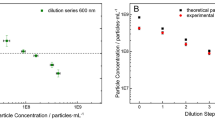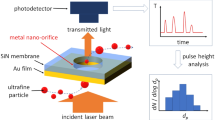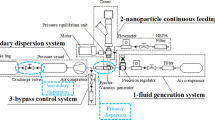Abstract
Acoustic force field has been studied for its use in trapping submicron particulates of various sizes and densities. Both wave and fluid dynamics have been used to study the effect of various particulate sizes and densities. A numerical model was used to arrive at quantitative trap efficiency data for the combined size and density variations. The particles used in the present work are assumed to be agglomerations of nanoparticles (ANPs) produced via the vapour condensation route. The particles present in the domain have considerable porosity and their skeletal densities are very dissimilar to their respective bulk densities. The study has been done for acoustic waves of frequency 40 kHz. Particles of uniform sizes and densities are introduced into the acoustic force field in independent case studies, to obtain trap efficiency of the system. The work presented not only elaborates on the effects of size and density on the trap efficiency, but also estimates trap efficiency for any given size less than 1 mm and density less than 150 kg/m\(^3\). These studies provide quantitative data for employing this technique in various areas dealing with synthesis and collection of ANPs. The study helps in addressing the major problem of contamination due to conventional collection methods as a result of their contact with the synthesis chamber. It also provides theoretical estimate of the quantities that can be effectively trapped/collected. Detailed analysis of the acoustic forces on the ANPs present in the domain have been reported in the present work.











Similar content being viewed by others
References
W Altberg, Ann. der Phys. 328, 267 (1907)
D Foresti, M Nabavi, M Klingauf, A Ferrari and D Poulikakos, Proc. Natl Acad. Sci. 110, 12549 (2013)
T Hoshi, Y Ochiai and J Rekimoto, Jpn. J. Appl. Phys. 53, 07KE07 (2014)
M A B Andrade, A L Bernassau and J C Adamowski, Appl. Phys. Lett. 109, 044101 (2016)
D Baresch, J L Thomas and R Marchiano, J. Appl. Phys. 113, 184901 (2013)
S Ann Seah, B W Drinkwater, T Carter, R Malkin and S Subramanian, IEEE Trans. Ultrasonics Ferroelectrics Frequency Control 61, 1233 (2014)
C R P Courtney, C E M Demore, H Wu, A Grinenko, P D Wilcox, S Cochran and B W Drinkwater, Appl. Phys. Lett. 104, 154103 (2014)
A Marzo, S Ann Seah, B W Drinkwater, D Ranjan Sahoo, B Long and S Subramanian, Nature Commun. 6, 8661 (2015)
D Baresch, J L Thomas and R Marchiano, Phys. Rev. Lett. 116, 024301 (2016)
J H Lopes, M Azarpeyvand and G T Silva, IEEE Trans Ultrasonics Ferroelectr. Freq. Control 63, 186 (2016)
T Tang and L Huang, J. Sound Vib. 509, 116256 (2021)
T Tang and L Huang, J. Sound Vib. 532, 117012 (2022)
T Tang and L Huang, Phys. Rev. E 105, 055110 (2022)
T Tang and L Huang, The J. Acoust. Soc. Am. 152, 2934 (2022)
T Tang, G Silva, L Huang and X Han, Phys. Rev. E 106, 045108 (2022)
T Tang, C Shen and L Huang, J. Sound Vib. 554, 117694 (2023)
W J Xie, C D Cao, Y J Lü and B Wei, Phys. Rev. Lett. 89, 104304 (2002)
L A Crum, The J. Acoust. Soc. Am. 50, 157 (1971)
S Z Hoque and A K Sen, Phys. Fluids 32, 072004 (2020)
A Lenshof, C Magnusson and T Laurell, Lab. Chip 12, 1210 (2012)
M Barmatz and P Collas, The J. Acoust. Soc. Am. 77, 928 (1985)
J Lee, S-Y Teh, A Lee, H H Kim, C Lee and K K Shung, Appl. Phys. Lett. 95, 073701 (2009)
G T Silva and A L Baggio, Ultrasonics 56, 449 (2015)
G T Silva, J H Lopes and F G Mitri, IEEE Trans. Ultrasonics Ferroelectrics Frequency Control 60, 1207 (2013)
D Baresch, J-L Thomas and R Marchiano, J. Acoust. Soc. Am. 133, 25 (2013)
J P Leão-Neto and G T Silva, Ultrasonics 71, 1 (2016)
J P Leão-Neto, J H Lopes and G T Silva, Phys. Rev. Appl. 6, 2 (2016)
G T Silva, J H Lopes, J P Leão-Neto, M K Nichols and B W Drinkwater, Phys. Rev. Appl. 11, 5 (2019)
B Zhao, H Shen and Y Kang, Powder Technol. 145, 47 (2004)
L P Gor’kov, Sov. Phys. Doklady 6, 773 (1962)
A Marzo, M Caleap and B W Drinkwater, Phys. Rev. Lett. 120, 044301 (2018)
B Zhao, H Shen and Y Kang, Powder Technol. 145, 47 (2004)
https://mega.nz/file/tdpWXZAC#o5VIhqFDcZbnMEPGgaNQWSPgzCXPZTTRQtrpnrUuIxU
Acknowledgements
This research activity received no external funding.
Author information
Authors and Affiliations
Corresponding author
Rights and permissions
About this article
Cite this article
KANDADA, S.P.R., Balasubramanian, C. Trapping of agglomerated nanoparticles by the acoustic field: influence of particle diameter and density on the trap efficiency. Pramana - J Phys 97, 195 (2023). https://doi.org/10.1007/s12043-023-02663-5
Received:
Revised:
Accepted:
Published:
DOI: https://doi.org/10.1007/s12043-023-02663-5




